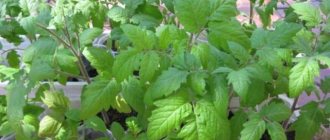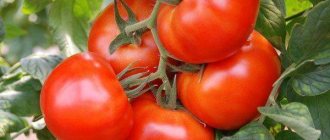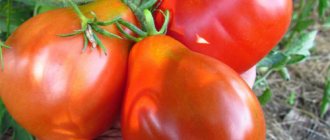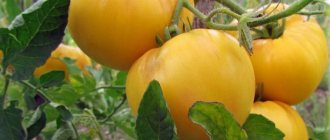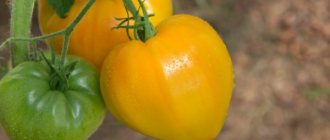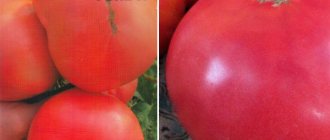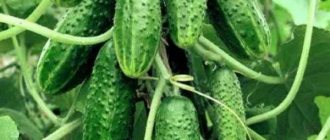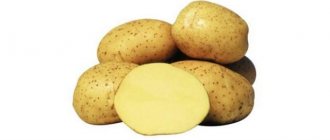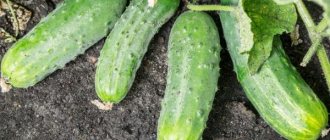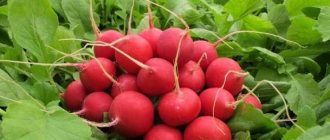Vegetable growing » Pumpkin
0
670
Article rating
Kira Stoletova
Vitamin pumpkin belongs to the nutmeg variety. It has a brown skin, crispy juicy flesh and few seeds. It does not require special storage conditions. The growing technology is simple, even a beginner can get a big harvest.
Features of growing vitaminnaya pumpkin variety
Useful properties of pumpkin
In addition to the fact that the orange beauty is an incredibly tasty vegetable, it also has numerous beneficial properties. The pulp of nutmeg pumpkin contains in large quantities:
- vitamins A, C, B, B6, E, K and others;
- potassium, magnesium, manganese.
The vegetable is dietary, low-calorie, and is widely used in baby food. In terms of carotene content, pumpkin is “ahead” of carrots, so it should be eaten by those who have vision problems.
Pumpkin fruits are false berries that help remove harmful waste and toxins from the human body, promote kidney health, and slow down the aging process of the body. It is useful to consume this tasty vegetable to improve blood clotting, for people suffering from heart disease, as well as for those who want to improve immunity.
Pumpkin must be on the menu, as it improves metabolism, preserves male strength and helps preserve the beauty of lovely ladies and burn “extra” pounds. Traditional healers consider this vegetable very useful for cancer patients. By the way, not only the pulp, but also pumpkin seeds are used in medicine. They are a very effective remedy in the fight against various parasites of the human body, and pumpkin seed oil is used in the treatment of the prostate gland in men.
And, of course, nutmeg pumpkin has found application in cooking. Its pulp is best consumed fresh, using in salads. Mashed potatoes, various side dishes and cereals turn out delicious; you can also make excellent pancakes from the pumpkin contents. Small nutmeg pumpkin is stuffed, and you can use vegetables or meat as a filling. Pumpkin pies, halva and candied fruits are popular.
Vitamin Pumpkin: description and characteristics of the variety
Butternut squash Vitamin: photo of the variety
A vegetable that has many kilograms of fruit should look impressive in size. Vitamin pumpkin has a powerful trunk with branches up to 7 meters in length. The large leaves are attached to the trunk by long cuttings covered with white hairs. The pedicels are long with bright yellow flowers with a pleasant aroma, which promotes the active process of pollination. The fruits of the Vitaminnaya pumpkin variety are oval or round in shape with a dense, smooth skin of various colors from beige to orange and coral. The skin of the pumpkin may show streaks or spots, or small ridges.
The taste of the nutmeg pumpkin variety Vitaminnaya is highly praised for the rich orange-yellow color of the juicy fibrous pulp with a pleasantly sweet aroma. Smoothies are often prepared from this variety of pumpkin. This drink, like pumpkin in general, is rich in vitamins A, C, pectin, vitamins B, D, PP, ascorbic acid, as well as quite rare vitamins T and K, which help synthesize blood protein and combat the symptoms of anemia.
Thanks to plant fibers, which are contained in large quantities in pumpkin, this vegetable has a good ability to quickly saturate the body. And ladies love melons, among other things, for their low calorie content, since 100 grams of pumpkin contains approximately 20-25 kcal, and their ability to lose weight. In addition, it will help normalize blood pressure and improve the functioning of the gastrointestinal tract, as well as maintain water-salt levels in the body. Pumpkin contains a lot of magnesium, potassium, manganese, each of which helps prevent the cardiovascular system, and will also help improve the external and internal condition of the skin and hair.
Landing
Sowing nutmeg pumpkin seeds does not require any particularly stringent conditions, but still some rules should be followed when planting the vegetable. In most regions of the country, this plant is grown by seedlings. To do this, you should adhere to the following steps:
- soak the seeds for 30 minutes in a solution of potassium permanganate;
- then at the same time we place the planting material in a solution of a growth stimulator, for example, “Epin”;
- wash the seeds in clean water and dry;
- place for germination in damp gauze;
- As soon as the seeds hatch, we plant them in containers with soil, two grains in each;
- cover the pots with film and put them in a dark, warm place;
- when the first sprouts appear, we take the containers to a lighted area, we no longer need the film;
- in each container we eliminate the weaker specimen;
- We make sure that the seedlings are not exposed to sudden temperature changes;
- We carry out regular watering;
- after 14 days, the containers can be taken out into the fresh air - a balcony or terrace - for hardening;
- Seedlings can be planted in open ground 3-4 weeks after planting.
Before planting pumpkin seedlings in the garden, you need to consider time. By this period, night frosts should already have passed, and the earth should warm up to +10 degrees, usually the end of May or the beginning of June. The soil in which the nutmeg pumpkin will grow also requires special conditions.
- This should be a warm and well-lit area. If you plant a vegetable in the shade, you are unlikely to expect a good harvest.
- It is better to choose a ridge at some elevation, since the crop is very susceptible to excess moisture.
- The soil should be nutritious and loose.
- It is recommended to plant the pumpkin next to a hole containing rotted grass.
- The soil requires fertilization with organic matter.
- When planting, it also doesn’t hurt to add compost to each hole.
If the seeds of this variety are planted directly in open ground, then the following rules are observed:
- soak the seeds in potassium permanganate and then treat them with a fungicide;
- digging holes at a distance of 1-1.4 meters;
- place 2 seeds in each hole to a depth of 5-6 cm;
- When the seedlings hatch, we thin them out, leaving only strong and strong plants.
Features of cultivation
It has tropical roots, so it is very thermophilic and prefers open, well-lit places. In the southern regions, this crop easily has time to ripen and produce a full harvest, but in the northern regions it is necessary to select early ripening varieties or grow it through seedlings.
Before planting, it is recommended to germinate the seeds, which will give additional time for the fruit to ripen. Seeds or seedlings are planted in the soil in the spring when the soil warms up at a depth of 10 cm above +10 degrees, and the possibility of return frosts should be excluded.
Until the plants have gained strength and formed a vine of at least one meter, it is necessary to carefully control weeds. After this, the leaves begin to cover the surface of the soil quite densely, which prevents the appearance of new weeds, and the plant becomes so powerful that it suppresses existing ones.
The plant spreads over a large area, and additional roots are formed in places where the leaf nodes come into contact with the soil, which increases the drought resistance and productivity of the crop. In this regard, it is not recommended to move the stems, especially during flowering, which can lead to the flowers falling off, and by moving the fruits, they may stop developing.
It responds well to watering by increasing productivity. It is recommended to water once a week until the first ovaries form. Then watering is reduced to once every 2 weeks, as this can cause cracking of the pumpkins.
Harvesting is carried out in the fall before frost, when the temperature at night drops to +10 degrees. Pumpkins are cut with pruning shears. It keeps very well in room conditions, but the optimal storage temperature is +10...+12 degrees, which allows you to save it until next summer.
Useful properties of butternut squash
Butternut squash contains a huge amount of nutrients, so its nutritional value is very high, unlike other varieties. The keratin content is significantly higher than that in carrots. In addition, pumpkin is rich in minerals, vitamin C and fiber, which improves heart function, etc. Eating this vegetable helps improve vision, slow down skin aging, as it contains antioxidants, strengthens blood vessels, helps cleanse the body of toxins and helps strengthen the immune system. As mentioned above, nutritionists like to recommend adding pumpkin to the diet of people who need not only maintain your figure, but also cope with obesity. This vegetable contains only 45 kcal. per 100 grams.
Care
The most unpretentious variety to care for is the “Vitaminnaya” nutmeg pumpkin. It is resistant to temperature changes and is not afraid of damp and windy weather, which often occurs in the summer in the middle zone. Description of the “Vitamin” pumpkin:
- suitable for growing in open ground;
- gives a large harvest in the conditions of the Russian Central region.
Pumpkin growing in open ground must be watered in the morning and evening, when there is no hot sun. If you water on a hot afternoon, the plant may die.
Pumpkin “Provence” and “Pearl” require special attention during the flowering period, since in the hot summer the flowers often dry out and fall off without forming ovaries. Therefore, it is necessary to water Provençal pumpkin during flowering at least twice a day.
If a gardener waters a pumpkin from a watering can, do not pour water close to the plant so as not to wash the roots. When watering with a hose, for the same reason, you should avoid strong water pressure.
In addition to watering, she needs:
- Mulching - the space between plants in the beds is filled with sawdust or dry straw;
- Weeding;
- Fertilizing with industrially produced mineral fertilizers.
When the plant begins to bear fruit, watering is gradually reduced to a minimum so that the pumpkin spends all its energy not on the formation of new shoots, but on the formation of the fruit.
For feeding, you should choose mineral fertilizers rich in phosphorus and potassium. Egg shells, bone meal, and diluted mullein are also great options. During the flowering period, fertilizing is intensified, and during the fruiting period it is temporarily stopped. Also, nutmeg pumpkin responds well to feeding with ash.
When the lashes begin to actively grow, they need to be carefully laid out on the ground. Then they will not strive upward, and flowers and ovaries will appear on the pumpkin faster.
Harvesting and application
The pumpkin reaches full maturity 130 days after the formation of seedlings. The harvest is usually harvested from mid-August to mid-September. The exact date depends on climatic conditions.
The fruits are harvested before the first cold weather sets in - the pumpkin cannot withstand frosts. A couple of weeks before harvest, watering is stopped. Cut fruits with a small stalk (5-6 cm) - this way they will be stored longer.
Application
Nutmeg pumpkin varieties are universal in use: they are equally tasty both raw and after heat treatment. It is rich in vitamins, and most of them remain even in a baked or boiled product. Vitamin is perfect for preparing salads and main courses.
It is used to bake pies and cookies, fry pancakes, cook porridge, jams, soups and sauces, and also make dumplings and freshly squeezed juices. Pumpkin pulp contains a large amount of carotene, so it is often used for baby and medical nutrition.
How to store
Before the onset of cold weather, the pumpkin is stored on a closed balcony or in another dry room. When the night temperature begins to drop below 5ºC, the fruits are moved to a warmer place. You can store vegetables in an apartment, but the optimal storage temperature is from +4 to +8ºC.
When the harvest is large, it is stored in the garden, in a trench. The top is covered with straw (a thick layer) and sprinkled with earth, leaving ventilation holes.
Pumpkin yield, harvesting and storage
Butternut squash has quite a decent level of productivity - but depending on the variety, the number and weight of fruits collected per 1 m2 may vary.
If you want consistently high yields, you should choose varieties such as:
- Arabatskaya (up to 20 kg);
- Pearl (up to 8 kg);
- Marble (up to 10 kg);
- Vitamin (up to 7 kg).
The level of productivity largely depends on proper care: if you grow pumpkin correctly, then any variety will delight you with strong, strong and juicy fruits.
Two weeks before the planned harvest, you need to stop watering the pumpkin. Harvesting is usually done from mid-August to mid-September - the exact date is determined by the early maturity of the variety and the climate of the region.
It is necessary to remove fruits from the garden in advance before the cold weather
This plant does not tolerate frosts or drops in temperature, so it is important to take this into account.
Carry out cleaning in dry weather: you need to cut the pumpkin with pruning shears, leaving a tail of 3-4 cm from the stalk. Do not forget that the skin of the butternut squash is unusually thin for such a large fruit, so try not to damage it. Fruits with damaged skins are poorly stored and soon begin to rot.
The pumpkin harvest must be stored dry and warm. Note that correctly collected and undamaged fruits are stored for a very long time - until spring. However, six months after harvesting, you may notice a deterioration in the taste of the pumpkin - because of this, it is advisable to eat it earlier.
Bloom
Butternut squash has male and female flowers that are pollinated by bees, so the plant will grow well in a beekeeping area. The crop begins to bloom approximately 50 - 55 days after planting.
Marble Pumpkin
The Muscat de Provence pumpkin begins to bloom earlier than everyone else - on the 45th - 48th day from the moment of planting in the greenhouse, on the 50th day from the moment of planting in open ground.
Note! Female flowers appear about a week later than male ones. During flowering, it is necessary to increase watering
When growing this crop, gardeners often encounter “barren flowers” - flowers that do not set an ovary. To solve this problem, during the flowering period you need to spray the plants one or several times with a special “Ovary” product. This product promotes the formation of ovaries and healthy large fruits
During flowering, it is necessary to increase watering. When growing this crop, gardeners often encounter “barren flowers” - flowers that do not set an ovary. To solve this problem, during the flowering period you need to spray the plants one or several times with a special “Ovary” product. This product promotes the formation of ovaries and healthy large fruits.
Productivity
Pumpkin Honey
In Russia, early-ripening and mid-ripening varieties of nutmeg pumpkin produce the most harvest. The most productive mid-season variety is considered to be “Marble” (up to 10 kg, 130 days from planting to harvest). The most productive early ripening variety is considered to be the Prikubanskaya variety (up to 12 kg, 100 days from planting to harvest). But the Prikubanskaya pumpkin is very demanding on temperature conditions, so to get a large harvest it should be grown in a greenhouse.
The number and weight of fruits collected per square meter of plot depends on the care of the plant, as well as on the weather, and may vary from year to year.
Pumpkin harvest
Advantages and disadvantages
The pearl has both advantages and disadvantages.
The advantages of the Pearl pumpkin include:
- drought resistance;
- resistance to low temperatures;
- high taste characteristics;
- Pearl pumpkin has a pleasant aroma;
- the shape of the fruit is very convenient for storage and use;
- high pulp content due to small cavity for seeds;
- excellent ability to be stored for a long time;
- ability to transport over long distances.
There are no significant deficiencies in the variety
. Conventionally, we can distinguish: susceptibility to disease, the presence of peculiarities in relation to the composition of the soil, care, as well as a significant deterioration in taste properties during very long storage.
Advantages of the variety
The nutmeg pumpkin has many advantages compared to other varieties common on the plots of Russian summer residents. Its fruits contain a large amount of valuable vitamins and minerals necessary for the normal development of the body. Thanks to its taste, you can prepare a variety of dishes from nutmeg pumpkin: porridge, dumplings and manti with pumpkin pulp, pies and dietary puree soups for baby food. Also among the advantages are the following:
- A large number of early ripening varieties;
- The ability of a plant to do without watering for some time;
- Easy to pollinate, no need for artificial pollination;
- The speed of formation of buds and ovaries, a long period of flowering and fruiting.
Among the obvious advantages are the high yield of individual varieties, as well as a large mass of fruit. But it should be taken into account that it is possible to obtain a large harvest of “record-breaking” pumpkins only if this crop is properly cared for and in favorable weather conditions.
Pumpkin is good for dietetics
Beneficial features
This is one of the best dietary foods that is easily digestible. It has a low calorie content: 100 g of pulp contains only 17-31 kcal. Thanks to this, it is used for losing weight and maintaining a slim figure. It has a fairly high content of vitamins E, group B, PP, mineral salts, and provitamin A in the pulp is 2-3 times more than in carrots. With its regular use, the mass of adipose tissue decreases. It helps remove harmful toxins from the human body and is useful for improving immunity. It is also used to improve the health of the kidneys and liver, having a laxative and weak choleretic properties. The vitamin K it contains, when consumed regularly, helps slow down the aging process and improves blood clotting.
The seeds are also useful. They are used to expel parasites from the human body; for this it is enough to consume 2-3 seeds per day. Also, the proteins and microelements contained in the seeds improve brain activity and help improve memory. The most beneficial oil is squeezed out of the seeds, which is used to improve the activity of the prostate gland, which has a beneficial effect on the sexual abilities of men.
What types of pumpkins are there?
The pumpkin fruit is a false berry and is called pumpkin, so we can say that it is the largest berry.
There are many different pumpkins in nature. This also includes decorative pumpkins. All edibles are grouped into three types: hard-barked, large-fruited and nutmeg. They have various subspecies.
The most common is hard-bark, which has many varieties and the sweetest varieties; it also includes zucchini and squash. It has mostly small fruits, but the maximum weight of individual specimens can reach 15 kg or more. This species was named for its very dense bark, which allows the fruit to be preserved for three or more months. Pumpkins are pale to brown-orange in color with stripes.
This species has a subspecies gymnosperm, the seeds of which are edible without preliminary cleaning. During heat treatment, the pulp of fruits of another subspecies breaks down into fibers that look like boiled long pasta. It was called spaghetti squash.
Large-fruited is distinguished by record fruit sizes (up to 500 kg!), but the taste of its pulp leaves much to be desired. It also has thick, and sometimes very thick, bark, and is stored almost until the next harvest. Due to its durable properties, it is used to produce figures that are used at Halloween.
The nutmeg pumpkin has the most delicious fruits. Pumpkins have a mild nutmeg flavor. Native to Central America, southern Mexico, Colombia and Peru, where it is often found growing wild today. It accumulates a record amount of sugar (up to 15%), which makes the pulp sticky when cut, and a large amount of carotene, coloring the pulp in shades of orange. Almost all of them have a fairly thin bark that can be easily peeled off with a knife. Pumpkins are almost completely filled with pulp with a small amount of seeds. The fruits range in size from small to quite large, but the smaller they are, the better their taste. It has six subspecies, which differ in the shape of the fruit. The Turkmenistan subspecies has elongated fruits, the Colombian subspecies has pepper-shaped fruits, the North American subspecies has flattened to cylindrical fruits, and the Indian subspecies has round or oval fruits. The Japanese pumpkin has wrinkled and warty fruits, while the Mexican pumpkin has a woody bark and powdery sweet pulp. Sometimes the term musk pumpkin is used, however, it is still the same nutmeg.
Pumpkin Muscat de Provence: variety description
Muscat de Provence
The appearance of the crop resembles a herbaceous plant with powerful stem shoots that spread along the surface of the ground. Their number can reach more than five pieces. The length of the lashes grows up to three meters.
The surface of the stems is covered with small hooks that grab onto any supporting structure. Thus, the plant grows rapidly upward. In addition, there are large foliage on the stems.
During flowering, large buds of a soft yellow color appear on the crop. They are shaped like a bell with several petals. This period usually occurs at the end of spring.
The plant blooms for two to three days. The variety needs pollinating insects, such as bees. If the natural process of pollination is not possible, it is carried out artificially.
Characteristics of vegetables.
Pumpkins of the Muscat de Provence variety are quite large. They reach a mass of up to ten kilograms. The shape of the vegetables is round, flattened on the sides. The fruits are characterized by a dirty orange color. Externally, the pumpkin is divided into equal segments.
In the early stages of ripening, vegetables have a characteristic greenish color. The top of the pumpkin is covered with a thick, hard skin.
Inside the fruit there is juicy orange pulp. It has amazing taste. In addition, Muscat de Provence vegetables are a rich source of vitamins and microelements for the human body.
Most often, Muscat de Provence vegetables are used to make drinks and purees. However, they are great for eating raw. The fruits are low in calories. This allows them to be included in the dietary diet.
Due to their beneficial properties, vegetables are recommended to be regularly consumed by people suffering from diseases of the heart, blood vessels and digestive organs.
But not only eating the pulp can have a beneficial effect on the human body. Vegetable seed oil will bring a lot of benefits.
It is worth noting that only fully ripe vegetables can be beneficial and delight with a sweet taste.
The fruits of this variety remain fresh for a long time. The harvest can be stored throughout the winter.
Diseases and pests
This crop rarely gets sick and is affected by parasites; this only happens if it is not properly cared for and the rules of agricultural technology are not followed. Sick plants reduce productivity, taste, dry out and die.
The most common butternut squash diseases:
- Black mold. First, yellow spots appear between the veins of the leaves; over time, they become covered with a brown fungal coating. The affected parts dry out and holes appear in their places. On fruiting bushes affected by this disease, pumpkins develop small and deformed.
- Ascochytaosis. The leaf blade, shoots and internodes are covered with yellow spots with black spots. At an advanced stage of fungal infection, plants wither, dry out and die.
- Powdery mildew. This disease develops in conditions of high humidity and heat. A powdery coating appears on all organs of the bush, which causes the foliage and the entire plant to dry out.
- Anthracnose. The leaves are covered with large watery yellow spots. In conditions of high humidity, the veins on the foliage become pinkish. The infection multiplies rapidly and spreads to all healthy organs. The affected areas turn black and die.
- White rot. This disease affects all parts of the plant - from the root system to the tips of the shoots. The fruits develop deformed, the stems are covered with a slimy coating, which turns brown and black over time. The spreader of this disease is slugs and slugs, which parasitize in dense plantings.
- The melon aphid is the most common and inveterate pest of this garden crop. Microscopic insects damage all organs - flowers, leaves, ovaries, shoots, sucking the juices out of them. The affected parts begin to curl and die.
- Wireworms. The ideal environment for click beetle larvae is waterlogged soil. Small insects damage the roots of young seedlings, causing the seedlings to wither and die.
- Slugs. The peak of the invasion occurs in wet and rainy weather. Slugs love to feast on succulent foliage - they gnaw out all the tissue, leaving only veins.
- Poduras are small white insects, no more than 2 mm long, that eat the aerial parts of young pumpkins. Parasites cause the greatest damage to plantings in damp and rainy weather.
Control and prevention measures
Butternut squash is resistant to diseases, but for prevention purposes it is necessary:
- adhere to the rules of crop rotation;
- observe agricultural practices;
- carry out high-quality selection and pre-sowing preparation of seed material;
- spray the garden bed in spring and autumn with Fitosporin.
At the first signs of damage, the plantings should be treated with copper-containing preparations - Bordeaux mixture or copper sulfate.
#Pumpkin. Nutmeg pumpkin varieties. Pumpkin harvest 2021.
Butternut squash - butternut
butternut squash Guitar
To combat aphids, the drugs Karbofos or Phosfamide are used; a soap-ash solution helps at the early stage of infestation. You will have to fight slugs manually - insects are periodically collected or beer traps are placed on the site.
Baits will help you catch wireworms - in several places you need to dig holes 0.5 m deep and place crushed and peeled root vegetables, which the parasites love to eat, on their bottom. The top of the pits should be covered with plywood or boards. A simple method will help to destroy the dur - dusting the soil in the garden bed with wood ash.
Plant parameters
Pumpkin Butternut
Different varieties of butternut squash have different flowers, leaves, and connections. For example, for pumpkin variety “Pearl” the variety description is different from “Marble”.
Butternut squash blossom
On average these parameters are:
- Plant height 55 - 70 cm;
- Fruit sizes are 0.7 - 1 m in length;
- Fruit weight 8 - 18 kg;
- The shape of the fruit is cylindrical, similar to the shape of a zucchini;
- Leaf size is medium;
- The shape of the leaves is heart-shaped, the outside of the leaves are covered with soft fluff.
The leaves of a healthy plant are dark green. Lightening and yellowing of leaves can signal a lack of nutrition and moisture, bacterial and fungal infections.
How to plant pumpkin seeds?
To get strong seedlings, you must do the following:
- Keep the seedlings at home for about a month.
- Then prepare the containers in advance. It is better that they are separate for each plant. They are filled with special soil for growing seedlings.
- Plant 2 seeds in each container.
- The containers are covered with film to maintain soil moisture and placed in a dark, but most importantly, warm place.
- As soon as the shoots appear, it is recommended to remove the film and move the plants to a well-lit windowsill.
- Then a strong plant is selected from the seedlings, and the weak one is removed. Leaving only one sprout.
- After half a month has passed, it is necessary to begin hardening the plants. It is recommended to take them out onto the balcony, gradually lengthening the time.
- At the end of May or June, it is recommended to plant pumpkin sprouts in open ground.
When planting seedlings in open ground, it is necessary to monitor the temperature in the air and soil: it should not be lower than 15 °C. Pumpkin is afraid of the slightest frost. It's better to wait until the weather settles.
Planting methods and timing
Vitamin pumpkin is an extremely heat-loving plant, for which temperature changes are fraught with falling leaves, blackening of the trunk and death. In this regard, it is best to grow pumpkin in seedlings. Direct sowing in open ground is permissible only for residents of the southern regions, where the crop can be harvested in mid-autumn and without fear of frost.
In any case, at the time of planting, the soil temperature should be at least +13°C, otherwise the tender roots will die in a cool environment. This will be indicated by withered leaves covered with dark spots.
The timing of planting depends on the method of cultivation:
- Through seedlings. You need to sow the seeds in April in order to transplant the seedlings into open ground in May-June. In this case, the temperature on the thermometer should already remain steadily at least 20°C.
- Direct sowing of seeds into the ground. Sowing work can be carried out at the end of May - at the beginning of June, when the risks of uninvited frosts will be minimized. To determine the optimal time for sowing seeds, you can also rely on folk signs. They say that pumpkin can be planted when viburnum and peonies begin to bloom.
Pumpkin Pearl: growing variety
To obtain a good harvest, the creation of suitable favorable conditions will be required. When choosing the right place to plant the Pearl pumpkin, it should be illuminated from all sides, and the soil should be heated to a temperature of 10 to 12 degrees. In this case, the soil is preferably sandy loam or slightly loamy. The place must be protected from winds and drafts.
Preparing pumpkin seeds for planting
Before planting the seeds, they should be properly treated. To do this, prepare a saturated solution of potassium permanganate, soaking the seeds in it for 2 to 3 hours. For additional prevention, thoroughly dried planting seeds are treated with a fungicide.
Preparing a pumpkin bed
The beds are prepared in advance, for which the soil is moistened, loosened, and appropriate nutrients are added. Both organic and mineral fertilizers are poured to the bottom.
On a note!
If cucumbers grew at the site planned for planting, you do not need to apply additional fertilizing.
Planting holes for pumpkin crops are located at a distance of 1 to 1.5 meters from each other
It is important that the bushes do not interfere with each other. Maintain a distance of 1.5 meters between beds
Planting pumpkin seeds Pearl
Pearl pumpkin seeds are planted either at the very end of spring or at the beginning of summer. As a rule, at the beginning of June the earth is already warm enough. The sprouts feel good and begin to develop at temperatures from 18 to 25 degrees.
Planting pumpkins in open ground in spring
A pair of seeds is placed in the hole, placing them 5-6 cm deep into the soil. Sprinkle earth on top. The sprout must grow on its own.
Planting through seedlings
When growing pumpkin in seedlings, the probability of obtaining a rich harvest is greater than when directly sowing seeds in the ground, however, this method is also more labor-intensive, so it is advisable to roughly divide it into several stages.
Seed preparation
The following processing of self-harvested or purchased seeds is carried out sequentially:
- Warming up. The seed should be spread in a thin layer on a pallet and kept for 1-2 months in a warm place, for example, near a stove. Such manipulation will allow the plant to produce a larger number of female flowers, which will have a positive effect on the crop yield.
- Germination test. After warming up, the seeds need to be soaked in a saline solution. Those specimens that emerge must be caught and destroyed, since they are empty and will not produce any shoots. The seeds remaining at the bottom can be used for further processing.
Hardening. In order for future seedlings to withstand temperature changes, they need to be hardened. For these purposes, selected specimens will need to be wrapped in a damp cloth and kept in the refrigerator for 3 days. Disinfection. Carried out to protect the future plant from pest attacks. To do this, the seeds need to be soaked for 10-12 hours in warm water with the addition of a small amount of potassium permanganate or aloe juice.
Sowing seeds for seedlings
At the beginning of May, you can already plant seeds for seedlings. To do this, you will need to prepare separate peat pots, since the crop does not tolerate picking. In order for the root system of the plant to fully develop, the planting containers must be spacious and have a diameter of at least 10 cm.
Planting seeds is done in the following order:
- Fill the pots with nutritious soil.
- Make 2 cm indentations in the pots and place 1-2 seeds in them.
- Lightly sprinkle the holes with soil, and then water it with a spray bottle to lightly moisten it.
- Cover the plantings with plastic wrap to create a mini-greenhouse.
- Place the containers in a sunny place and regularly open the film for ventilation. With the appearance of the first shoots it can be completely removed. In addition, it is necessary to constantly maintain soil moisture, while avoiding excessive moisture.
Transplantation into open ground
The plant does not tolerate acidified soil well, so it is necessary to normalize its acidity after adding organic matter using wood ash. It is enough to scatter it over the beds or prepare a solution for irrigating the soil (2 tablespoons per 1 liter of water). The area should also be fertilized in the fall. An alternative option is to plant green manure.
It is worth replanting the seedlings into a properly prepared bed, following these instructions:
- Dig up the bed, clearing it of debris and plant debris.
- Break the earthen stones.
- Dig small holes 10 cm deep at a distance of 60-100 cm from each other. You should not allow very thick plantings, as this will prevent the wide leaves of the plant from spreading out to their full potential.
- Fill the dug holes with hot water (not lower than 50°C) at the rate of 2 liters per hole if the weather is dry.
- Plant one stem in each hole and cover with soil, completely covering the root collar.
- Mulch the planting with manure or peat. If there is a threat of night frosts, the planting should be temporarily covered with a transparent film.
Fodder pumpkin in dacha farming
Feed pumpkin is a valuable, succulent food for farm animals. Its fruits can be processed and are used for making silage with grain waste and feeding fresh.
Beneficial properties of fodder pumpkin
- Increased growth in pigs.
- The amount of milk production increases and the fat content of milk increases.
- Helps increase the reproductive capacity of animals.
- High yield level due to large fruits.
The disadvantages include the lack of a pleasant aroma and low culinary properties.
Hundred Pounds
The Stofuntovka pumpkin variety is a popular mid-season with high yield. The plant has spherical fruits, which are covered with yellow or orange skin with a grayish tint, have excellent shelf life and are well stored throughout the winter, and are not damaged during transportation.
Volzhskaya gray 92
Volzhskaya gray 92 - resistant to diseases and dry weather. The plant bears fruit in the Volga region and produces the richest harvests. The weight of grayish-white flat-round fruits exceeds 25 kg. The pulp is medium juicy, quite dense, and has a rich yellow color with an orange tint.
Muscat pumpkin varieties with photos and descriptions
Butternut squash differs from its counterparts in having a much more subtle nutmeg aroma and does not have that characteristic pumpkin flavor. Therefore, a group of muscat varieties is considered a delicacy on the table. Moreover, they are not the sweetest among all pumpkins, since they accumulate sugar only 6%.
They are no longer cooked as vegetables, but as fruits. Butternut squash is used as an additive to porridge; it is used to make salads, pie fillings, and thick juices. It is also good in the form of jam.
Vitamin
The variety is medium late, ripens 130 days after planting. The fruits are oval in shape, sometimes slightly cylindrical. The peel is brownish-orange in color, spotted and striped. The pulp is reddish in color, quite thick - up to 6-10 cm. There is little sugar in it, but there are many different vitamins, which is why it got its name. In addition, pumpkin contains carotenoids and ascorbic acid. The weight of the fruit reaches 5-7 kg.
Nectar
The plant is creeping, reaches a length of up to 3 m. The fruits are orange, ribbed, weighing up to 6 kg.
The pulp is bright orange, juicy and sweet, with a pleasant aroma. The use is universal, but juices and purees are best prepared.
Arabatskaya
A mid-late variety that can be stored for a long time, almost 4-5 months. Therefore, it is suitable for those who like to eat pumpkin in winter. The skin of the fruit is thin and light orange. The pulp is dense, juicy and aromatic, has an orange color. Weight can reach 8 kg.
Provençal
The variety is mid-season, ripening occurs after 120 days. The fruits are round, slightly flattened. The peel is not thick, ribbed, the color is matte orange. Weight reaches 8 kg.
The color of the pulp is bright orange, the taste is good. Moreover, the longer the pumpkin is stored, the better its taste becomes. For culinary purposes, it is best suited for making candied fruits, desserts and juice.
Honey Princess
Like the previous variety, mid-season. Ripening occurs on day 115. The weight of the fruit is 4 kg, the color is orange. The pulp is bright orange, the taste is sweet.
The plant grows powerful, and therefore it must be planted at some distance from each other. There must be at least 100 cm between holes.
The variety is resistant to diseases and tolerates temperature changes well.
Hokkaido
An interesting early ripening variety that has recently begun to gain popularity. Its shape is unusual, reminiscent of an onion, it can be in the shape of a pear, as well as round or slightly flattened. The weight of the fruits is not very large and can reach from 700 g to 2.5 kg.
The flesh may be yellow or almost red. The taste is similar to sweet potatoes. The peel is green, gray and white. The fruits contain many useful substances. Demanding about watering and fertilizing.
Spanish guitar
Another unusually shaped variety with a medium ripening period. The fruits are shaped like a club or a guitar, which is why it got its name. The fruit grows up to one meter long and weighs from 5 to 10 kg. The peel is yellowish-green, the flesh is orange or yellowish. Juicy, sugary and crunchy, the taste is similar to carrots and apricots. The shelf life of the fruit is about three months.
How to grow
Pumpkin variety Guitar is grown in seedlings. However, in regions with a favorable climate, pumpkin can be grown by immediately planting the seeds in the ground.
Planting a plant
Pumpkin seeds begin to be planted in April. Before planting, they must be sorted out and disinfected. It is not necessary to process purchased seeds: information about the preventive measures taken can be read on the packaging.
Self-collected seeds from the previous harvest are treated with a solution of potassium permanganate and water. The seeds are then placed in a damp cloth for several days to allow them to sprout. Sprouted seeds are placed in small pots filled with peat.
After germination, the strongest sprout is selected, the weak ones are removed. Containers with seedlings are left on the south side, as the plant loves warmth and light. To prevent the soil from drying out under the rays of the sun, it is often moistened with water at room temperature.
After 3-4 weeks, the seedlings are planted in holes, abundantly watered. The plant is placed in rows; between the rows leave gaps of 1.3 m, and between the sprouts - at least 90 cm. After planting, the soil is compacted and, if necessary, covered with agrofibre.
Planting with seeds is carried out in the southern regions. Disinfected and germinated seeds are immersed in holes to a depth of 5-10 cm. 2-3 seeds are placed in one hole at once. Plants are watered and covered if necessary. After the sprouts appear, they are thinned out, leaving the strongest ones.
Plant care
This pumpkin variety is easy to care for. However, dense foliage needs thinning. And after 2-3 ovaries form on the stems, the pumpkin is pinched so that the plant is not overloaded and receives full nutrition. Side shoots are also cut off so that the fruits have time to ripen.
16-22 days after planting the seedlings, fertilizing is carried out. The second time fertilizer is applied during the period when the ovaries are formed.
Watering pumpkins is exclusively soil-based. Water should not get on the leaves, as this can lead to the formation of fungal diseases. When grown in greenhouses, pumpkin is watered 2 times a week with warm, settled water. In open ground, the plant needs enough natural precipitation. After watering, the soil must be loosened to ensure an influx of oxygen and kill weeds.
Features of cultivation and possible difficulties
The culture loves warmth and sunlight. Therefore, when planting sprouts in open ground, the weather should be warm, without the risk of recurrence of frost. When transplanted into the ground, the plant must have at least 3 grown leaves.
When looking for containers for pre-seeding, you need to choose spacious and deep containers so that the pumpkin root system does not experience discomfort. When transplanting, take the earthen ball carefully, since the pumpkin root is very delicate. Even with minimal destruction of the coma, the plant may die.
Growing tips from experienced gardeners
Experienced gardeners advise planting pumpkins on light, fertile sandy loam soils with the addition of humus. It is better to use a greenhouse made of polycarbonate, which allows sunlight to pass through. Moderate watering and ventilation are recommended.
In open soils they are planted when the soil temperature reaches +12°C. The soil is fertilized every fall so that when plants are planted in the spring, the soil is filled with the necessary nutrients.
Diseases and pests
With heavy summer rains and sudden changes in night and day temperatures, the plant is at risk of developing root rot and bacteriosis. For prevention, overgrown lashes are thinned out. If the plant is sick, it is necessary to remove the diseased parts, and after harvesting, collect and destroy the remains of the plants.
From time to time, a pumpkin can be attacked by spider mites or melon aphids. Insects are controlled by spraying insecticides and acaricides.
Further care
The secret of proper care is a standardized number of shoots. On average, it is necessary to leave 2-5 shoots, remove the weak ones, and place the strong ones in such a way as to avoid mutual darkening. In order to prevent shoots of medium and long length from rotting on the ground after heavy rains, it is necessary to place cellophane, plywood or mown grass under them.
A ripe fruit differs from a green one by its hard crust and drying base (the stem on which the fruit rests). To ensure that the pumpkins are well preserved, try not to deform them during harvesting, and also cut them off along with the base.
The best varieties of pumpkin need to be watered several times a week, but thoroughly, so that the soil has time to become saturated with water. Frequent watering is not recommended due to possible plant rotting.
Pumpkin care
It consists of carrying out a set of agrotechnical measures, each of which requires separate consideration.
Watering, loosening and weeding
There is no special scheme for watering the soil, but it must be regular to prevent the formation of a dry crust on the surface of the area. In this case, it is worth focusing on weather conditions: in drought it is worth irrigating the plant 2 times a day at the rate of 5 liters of water per bush, and in rainy weather - water as needed. Pumpkin also needs especially abundant watering (twice a day) during flowering and fruit set.
You need to pour warm water strictly at the root so that droplets do not fall on the leaves and vines. The fact is that they can leave behind dry spots and cause burns to the plant.
At the end of summer, it is necessary to reduce the frequency of watering and completely interrupt it 2 weeks before harvest. Otherwise, the skin of the fruit will be too thin and the flesh will be watery. Such a pumpkin cannot be preserved until winter, since it will quickly deteriorate.
Additionally, the ground under the bush should be mulched with humus or straw. This manipulation will retain moisture longer and prevent the growth of weeds.
Feeding
For nutmeg pumpkin varieties, the following fertilizing scheme is used:
- First feeding (before flowering). With the seedling method, it is carried out 7 days after planting the seedlings in open ground, and with direct sowing - after 3 weeks. For feeding, you should use a solution of mullein or manure, where most of the liquid is removed (1:10). You can also add mineral fertilizers to it - 30-40 g of superphosphate, 15-25 g of potassium sulfate per 10 liters of water.
- Second feeding (during flowering). The plant should be fed with a solution of 50 g of potassium sulfate and 15-20 g of nitrophoska per 10 liters of water. Until the ovaries appear, it can also be fertilized with wood ash or garden mixture at the rate of 50 g of dry matter per 10 liters of water. In case of cold summer, the plant can be additionally sprayed with a urea solution at the rate of 10 g per 10 liters of water.
If the application of organic fertilizers (mullein infusion or chicken manure diluted in water) increases the acidity of the soil, it will need to be lowered using wood ash. You can simply scatter it over the surface of the bed or add it with watering, having previously prepared a solution at the rate of 2 cups of ash per bucket of water.
Thinning
This manipulation is relevant only for direct sowing of seeds in open ground. It is carried out with the appearance of the first shoots. If 3-4 bushes sprout in one hole, you need to leave one or two of the strongest ones.
Thinning of seedlings is carried out only after the formation of several leaves. Weak specimens cannot be pulled out, as this can cause irreparable damage to all entrances. So, they need to be carefully cut at ground level with garden shears.
Bush formation
To get a good harvest, you must pay due attention to caring for the vines. This involves the following activities:
- During the development process, the pumpkin produces many weaving stems, which, with the help of tendrils, are fixed in the soil and supply the plant with nutrients along its entire length. As soon as it grows, in the places where the tendrils appear, such shoots should be sprinkled with earth and watered. They cannot be moved or cut.
- After the main stem reaches 1.5 m in length, it needs to be pinched.
- When forming bushes, you need to leave 2 lashes on each of them. The rest need to be carefully torn off.
- Leave 2-3 ovaries on one plant, since more fruits still won’t have time to ripen. To do this, the stems must be pinched 50 cm above the fruit.
- Pin the lashes to the ground in several places and sprinkle them with a layer of soil to speed up root formation and promote fruit growth.
Pest Control
Pumpkin is not the most attractive treat for pests. If they appear, it is mainly at the end of the growing season, when this crop ends its life cycle. Among them you can find:
- pumpkin glass;
- South American leaf beetles;
- edgers or diamondbacks.
The first pest poses a great danger because it eats the stems from the inside. After it attacks the plantings, the plant has little chance of survival. The listed pests must be controlled mechanically. This means that the plantings must be regularly inspected and any pests found must be manually removed.
Use in cooking
Butternut squash is a universal product, equally tasty both raw and cooked. Of course, some of the benefits are lost during cooking, but the vegetable is so rich in vitamins that most of them remain even in a boiled or fried product.
The fruits of this culture are perfect for making salads, stewing and frying; pumpkin is used to bake pies, pancakes and cookies, prepare porridge, soups, sauces, and stuffing. Try several recipes using this product.
Casserole:
- bake half a medium vegetable, remove the pulp and grind into puree;
- in a blender, together with the resulting pumpkin puree, beat 200 g of cottage cheese, 50 g of semolina and 50 g of granulated sugar;
- add 3 yolks and melted butter to the resulting mixture;
- Place the dough on a greased baking sheet;
- bake for half an hour until golden brown.
Stuffed butternut squash:
- Bake half a 1 kg pumpkin for 40 minutes;
- soak a handful of raisins in boiling water for 10 minutes;
- Coarsely chop two peeled sour green apples, fry with raisins for 3-4 minutes;
- Place 10 dried dates in a saucepan with heavy cream (250 g), bring to a boil and leave on low heat for 5 minutes;
- Remove the pulp from the baked pumpkin, leaving the walls a little less than 1 cm;
- combine the resulting pulp with apples and raisins;
- Fry a handful of cashews for 3 minutes, add to the apple and raisin mixture;
- place the indicated mass in the pumpkin, pour cream with dates, add another 250 g of cream;
- Place in an oven preheated to 200 degrees for half an hour.

